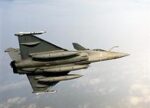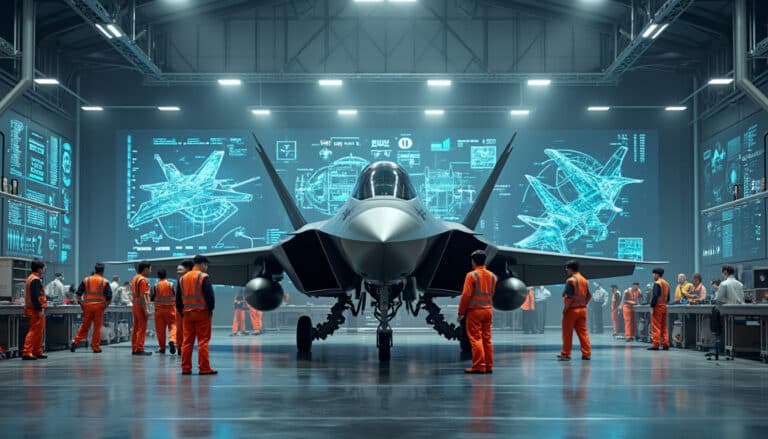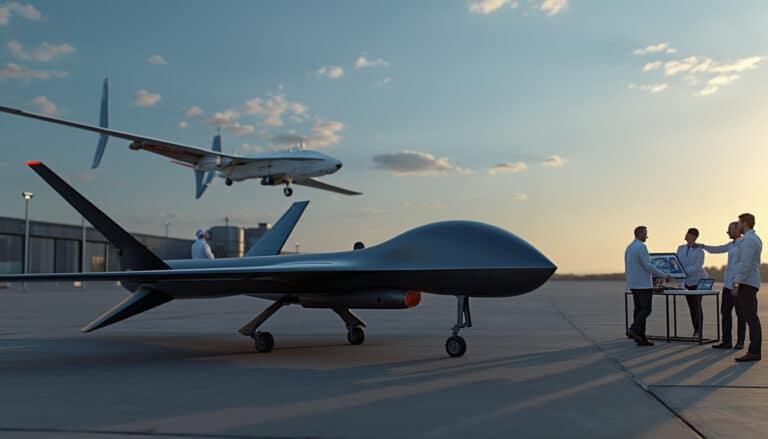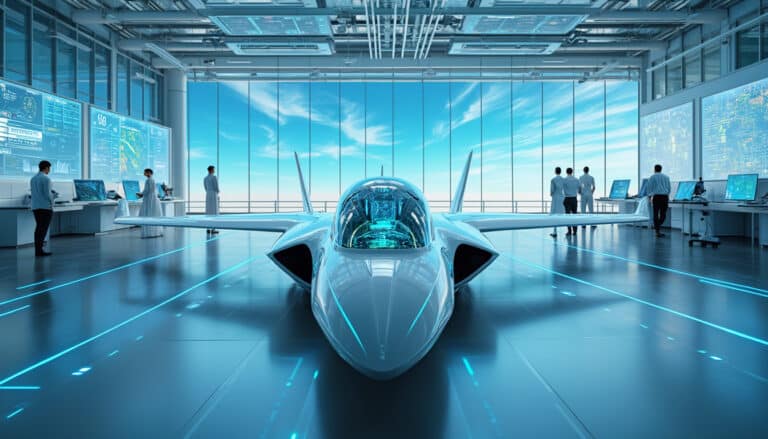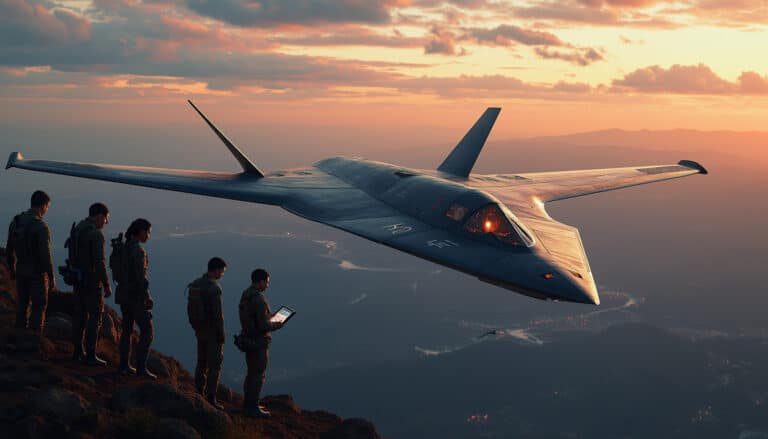The sea has become the theater of a silent revolution.
Unmanned systems are redefining naval tactics.
A new era of maritime warfare begins under the visionary command of the US Navy.
The integration of unmanned surface vehicles demonstrates the commitment of the U.S. Navy to enhance its operational efficiency. Through innovative programs like the Unmanned Systems Integrated Battle Problem 21, manned and autonomous capabilities are merging to create decisive tactical advantages. Current experiments in various U.S. fleets illustrate an unshakeable confidence in the potential of unmanned technologies. The ultimate goal is to combine artificial intelligence and cybersecurity to ensure strategic superiority on the oceans.

Table des matières
ToggleWho is Admiral Franchetti and what is her role in the mixed fleet?
Admiral Lisa Franchetti serves as the Chief of Naval Operations in the United States. With a distinguished career in the U.S. Navy, she plays a crucial role in modernizing and adapting naval forces to contemporary technological challenges. Franchetti is a strong advocate for the integration of manned and autonomous systems, firmly believing that the prototypes currently in development will pave the way for an innovative and effective mixed fleet. Her vision is based on leveraging advanced technologies to enhance the operational capacity of the Navy and ensure strategic superiority in international waters.
Why are prototypes essential for a mixed fleet?
Prototypes play a decisive role in the transition to a mixed fleet of manned and autonomous vehicles. By allowing new technologies to be tested and experimented in real-world environments, they provide a deep understanding of the capabilities and limitations of unmanned systems. The use of prototypes also helps to identify necessary improvements and refine operational concepts before large-scale adoption. For example, during the Unmanned Systems Integrated Battle Problem 21 (UxS IBP 21) launched on April 20, 2021, prototypes like the Sea Hunter demonstrated the feasibility and tactical advantages of autonomous systems, providing valuable data for future development.
What are the benefits of unmanned systems in the Navy?
The integration of unmanned systems presents numerous benefits for the U.S. Navy. First, they increase the range and resilience of naval operations by enabling extended missions without requiring rest for human crews. Second, they reduce risks to personnel by carrying out dangerous missions, such as surveillance and refueling in hostile environments. Furthermore, autonomous systems can be deployed in large numbers, providing strategic flexibility and rapid response capability to emerging threats. These advantages are essential for maintaining maritime superiority in an ever-evolving geopolitical context.
How is the U.S. Navy integrating manned and autonomous systems?
The integration of manned and autonomous systems is a complex process that requires careful planning and close coordination among different branches of the Navy. The U.S. Navy is adopting a multi-phase approach, starting with prototyping and experimentation, as outlined in the Future Years Defense Program (FYDP) covering five years from 2024 to 2028. This stage allows for testing technologies in various operational scenarios, including those of the drones-face-a-la-menace-au-moyen-orient/”>southeast command, before moving to the next phase which involves integrating these systems into acquisition programs and operational usage. Ultimately, the goal is to deploy a fully operational fleet mixing manned and autonomous units by the third budget defense plan.
What challenges remain to achieve an operational mixed fleet?
Despite significant progress, several challenges remain for achieving an effective mixed fleet. One of the main obstacles is the development of robust infrastructure and networks that can support the seamless integration of autonomous systems with manned platforms. Additionally, it is crucial to ensure the security and resilience of communications and data, especially in light of growing cyber threats. Another major challenge lies in the training and preparation of naval personnel to operate and maintain sophisticated autonomous systems. According to Franchetti, the U.S. Navy is also exploring the creation of a specialized category for robotics experts to effectively manage the future fleet.
What key technologies support the mixed fleet?
Several emerging technologies are essential for the success of the mixed fleet. Artificial intelligence and machine learning enable predictive maintenance, optimizing the availability and performance of ships. Additive manufacturing plays a crucial role in the rapid construction and repair of naval infrastructures, thus reducing downtime and increasing ship resilience. Advanced robotic systems also allow for continuous assessment of the material condition of ships, ensuring proactive and effective maintenance. In addition, initiatives like Project Overmatch aim to improve fleet-wide connectivity, facilitating rapid decision-making and optimal coordination of dispersed missions.
How is the Navy preparing its crews for the era of autonomous systems?
The U.S. Navy recognizes the critical importance of training and preparing its teams for a successful transition to autonomous systems. This includes creating more training opportunities focused on the use of advanced technologies, such as unmanned systems, big data, and additive manufacturing. Additionally, it is considering establishing a specialization in robotics to develop a group of experts capable of managing and maintaining the future fleet. This preparation aims to equip sailors with the necessary skills to fully leverage the advantages of emerging technologies, thereby ensuring a smooth integration of autonomous systems into daily operations.
What are the international impacts of the American mixed fleet?
The adoption of a mixed fleet also has significant repercussions on the international stage. Many allied countries and strategic partners are closely monitoring the advancements of the U.S. Navy in this area, seeking to learn and collaborate in the development of similar technologies. This creates opportunities for international collaboration, allowing for shared knowledge and strengthened collective maritime security. Moreover, the technological superiority provided by a mixed fleet can deter potential adversaries and ensure a dominant presence in strategic areas, thus contributing to overall geopolitical stability.
What concrete examples illustrate this transition to a mixed fleet?
A notable example of this transition is the deployment of the MQ-4C Triton, a maritime surveillance drone currently operating in Guam with imminent plans for deployment to the Naval Air Station Sigonella in Italy, as well as Bahrain. Additionally, the MQ-25 Stingray, an unmanned carrier-based refueling aircraft, is expected to achieve initial operational capability by 2026, thereby enhancing the autonomy and lethality of carrier groups. These initiatives demonstrate tangible progress toward an integrated fleet, where autonomous systems complement and enhance the capabilities of piloted vessels, thereby creating a more flexible and effective naval force.
How do technological innovations influence naval strategy?
Technological innovations are profoundly transforming naval strategy by providing new tactical and operational possibilities. The integration of autonomous systems allows for greater dispersion of forces, reducing vulnerabilities and increasing resilience against adversarial threats. Technologies such as artificial intelligence and data analytics improve real-time decision-making, enabling faster and more precise responses to complex situations. Furthermore, enhanced connectivity through projects like Project Overmatch ensures smooth coordination among the various elements of the fleet, maximizing operational efficiency and the ability to respond to crises in a coordinated and harmonized manner.
What is the future of the mixed fleet according to Franchetti?
Admiral Franchetti is convinced that the future of the U.S. Navy lies in a perfectly integrated mixed fleet, combining the advantages of manned and autonomous systems. She predicts that this evolution will not only enhance operational capacity and flexibility but also maintain American military superiority for decades to come. According to her, current prototyping and experimentation efforts are essential to prepare for the transition and ensure the Navy remains at the forefront of technological innovation. Franchetti also emphasizes the importance of international collaboration and ongoing investment in research and development to fully realize the potential of a mixed fleet.
#>










